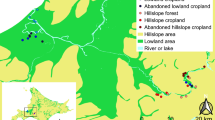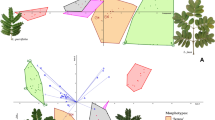Abstract
For most animal and plant species, life traits strongly affect their species-specific role, function or position within ecological communities. Previous studies on ant communities have mostly focused on the role of dominant species and the outcome of interspecific interactions. However, life traits of ant species have seldom been considered within a community framework. This study (1) analyses life traits related to ecological and behavioural characteristics of dominant and subordinate ant species from 13 sites distributed throughout the Iberian Peninsula, (2) determines how similar the ant species are within each of the two levels of the dominance hierarchy, and (3) establishes the distribution patterns of these different groups of species along environmental gradients. Our results showed that the differences between dominants and subordinates fall into two main categories: resource exploitation and thermal tolerance. Dominant species have more populated colonies and defend food resources more fiercely than subordinates, but they display low tolerance to high temperatures. We have identified different assemblages of species included within each of these two levels in the dominance hierarchy. The distribution of these assemblages varied along the environmental gradient, shifting from dominant Dolichoderinae and cryptic species in moist areas, to dominant Myrmicinae and hot climate specialists mainly in open and hot sites. We have been able to identify a set of life traits of the most common Iberian ant species that has enabled us to characterise groups of dominant and subordinate species. Although certain common features within the groups of both dominants and subordinates always emerge, other different features allow for differentiating subgroups within each of these groups. These different traits allow the different subgroups coping with particular conditions across environmental gradients.



Similar content being viewed by others
References
Andersen AN (1992) Regulation of “momentary” diversity by dominant species in exceptionally rich ant communities of the Australian seasonal tropics. Am Nat 140:401–420
Andersen AN (1995) A classification of Australian ant communities, based on functional groups which parallel plant life-forms in relation to stress and disturbance. J Biogeogr 22:15–29
Andersen AN (1997) Functional groups and patterns of organisation in North American ant communities: a comparison with Australia. J Biogeogr 24:433–460
Andersen AN, Patel AD (1994) Meat ants as dominant members of Australian ant communities: an experimental test of their influence on the foraging success and forager abundance of other species. Oecologia 98:15–24
Arnan X, Rodrigo A, Retana J (2006) Post-fire recovery of Mediterranean ground ant communities follows vegetation and dryness gradients. J Biogeogr 33:1246–1258
Arnan X, Rodrigo A, Retana J (2007) Uncoupling the effects of shade and food resources of vegetation on Mediterranean ants: an experimental approach at the community level. Ecography 30:161–172
Arnan X, Gaucherel C, Andersen AN (2011) Dominance and species co-occurrence in highly diverse ant communities: a test of the interstitial hypothesis and discovery of a three-tiered competition cascade. Oecologia 166:783–794. doi:10.1007/s00442-011-1919-y
Baroni-Urbani C, Bolton B, Ward P (1992) The internal phylogeny of ants (Hymenoptera: Formicidae). Syst Entomol 17:301–329
Bestelmeyer BT (2000) The trade-off between thermal tolerance and behavioural dominance in a subtropical South American ant community. J Anim Ecol 69:998–1009
Blüthgen N, Stork NE, Fiedler K (2004) Bottom-up control and co-occurrence in complex communities: honeydew and nectar determine a rainforest ant mosaic. Oikos 106:344–358
Bourke AFG (1999) Colony size, social complexity and reproductive conflict in social insects. J Evol Biol 12:245–257
Cerdá X, Retana J (1997a) Links between worker polymorphism and thermal biology in a thermophilic ant species. Oikos 78:467–474
Cerdá X, Retana J (1997b) Interference interactions and nest usurpation between two subordinate ant species. Oecologia 113:577–583
Cerdá X, Retana J (2000) Alternative strategies by thermophilic ants to cope with extreme heat: individual versus colony level traits. Oikos 89:155–163
Cerdá X, Retana J, Bosch J, Alsina A (1989) Daily foraging activity and food collection of the thermophilic ant Cataglyphis cursor (Hymenoptera, Formicidae). Vie Milieu 39:207–212
Cerdá X, Alsina A, Retana J (1990) Coexistencia de tres especies simpátridas del género Camponotus Mayr (Hymenoptera, Formicidae). In: Arias de Reyna L, Recuerda P, Redondo T (eds) Principios en etología. Publ Monte de Piedad y Caja de Ahorros de Córdoba, Córdoba, pp 117–130
Cerdá X, Retana J, Cros S (1997) Thermal disruption of transitive hierarchies in Mediterranean ant communities. J Anim Ecol 66:363–374
Cerdá X, Retana J, Manzaneda A (1998a) The role of competition by dominants and temperature in the foraging of subordinate species in Mediterranean ant communities. Oecologia 117:404–412
Cerdá X, Retana J, Cros S (1998b) Critical thermal limits in Mediterranean ant species: trade-off betwen mortality risk and foraging performance. Funct Ecol 12:45–55
Cerdá X, Retana J, Cros S (1998c) Prey size reverses the outcome of interference interactions of scavenger ants. Oikos 82:99–110
Chesson P, Huntly N (1988) Community consequences of life-history traits in a variable environment. Ann Zool Fenn 25:5–16
Colwell RK, Futuyma DJ (1971) On the measurements of niche breadth and overlap. Ecology 52:567–576
Cros S, Cerdá X, Retana J (1997) Spatial and temporal variations in the activity patterns of Mediterranean ant communities. Ecoscience 4:269–278
Deslippe RJ, Savolainen R (1995) Mechanisms of competition in a guild of formicine ants. Oikos 72:67–73
Fellers JH (1987) Interference and exploitation in a guild of woodland ants. Ecology 68:1466–1478
Futuyma DJ, Moreno G (1988) The evolution of ecological specialization. Annu Rev Ecol Syst 19:207–233
Gibb H, Hochuli DF (2004) Removal experiment reveals limited effects of a behaviorally dominant species on ant assemblages. Ecology 85:648–657
Giraud T, Pedersen JS, Keller L (2002) Evolution of supercolonies: the Argentine ants of southern Europe. Proc Natl Acad Sci USA 99:6075–6079
Hölldobler B, Wilson EO (1990) The ants. Springer, Berlin
Holway DA (1998) Effect of Argentine ant invasions on ground-dwelling arthropods in northern California riparian woodlands. Oecologia 116:252–258
Human KG, Gordon DM (1996) Exploitation and interference competition between the invasive Argentine ant, Linepithema humile, and native ant species. Oecologia 105:405–412
Human KG, Weiss S, Sandler B, Gordon DM (1998) Effects of abiotic factors on the distribution and activity of the invasive Argentine ant (Hymenoptera: Formicidae). Environ Entomol 27:822–833
Lach L, Parr CL, Abbott KL (2010) Ant ecology. Oxford University Press, Oxford
Legendre P, Vaudor A (1991) The R package: multidimensional analysis, spatial analysis. Departement de sciences biologiques, Université de Montreal, Quebec
Marsh AC (1985) Microclimatic factors influencing foraging patterns and success of the thermophilic desert ant, Ocymyrmex barbiger. Insect Soc 32:286–296
McGill BJ, Enquist BJ, Weither E, Westoby M (2006) Rebuilding community ecology from functional traits. Trends Ecol Evol 21:178–185
McGlynn TP (1999) The worldwide transport of ants: geographic distribution and ecological invasions. J Biogeogr 26:535–548
Melville J, Harmon LJ, Losos JB (2006) Intercontinental community convergence of ecology and morphology in desert lizards. Proc R Soc Lond B 273:557–563
Ninyerola M, Pons X, Roure JM (2005) Atlas Climático Digital de la Península Ibérica. Metodología y aplicaciones en bioclimatología y geobotánica. ISBN 932860-8-7. Universidad Autónoma de Barcelona, Bellaterra
Orshan G (1983) Approaches to the definition on Mediterranean growth forms. In: Kruger FJ, Mitchell DT, Jarvis JUM (eds) Mediterranean-type ecosystems. The role of nutrients. Springer, Berlin, pp 86–100
Parr CL (2008) Dominant ants can control assemblages species richness in a South African savanna. J Anim Ecol 33:830–838
Pekas A, Tena A, Aguilar A, García-Marí F (2011) Spatio-temporal patterns and interactions with honeydew-producing Hemiptera of ants in a Mediterranean citrus orchard. Agric For Entomol 13:89–97
Pisarski B, Vepsäläinen K (1989) Competition hierarchies in ant communities (Hymenoptera, Formicidae). Ann Zool 42:321–329
Purvis A, Gittleman JL, Luh HK (1994) Truth or consequences: effects of phylogenetic accuracy on two comparative methods. J Theor Biol 167:293–300
Putman RJ (1994) Community ecology. Chapman & Hall, London
Retana J, Cerdá X (1995) Agonistic relationships among sympatric Mediterranean ant species (Hymenoptera: Formicidae). J Insect Behav 8:365–380
Retana J, Cerdá X (2000) Patterns of diversity and composition of Mediterranean ant communities tracking spatial and temporal variability of the thermal environment. Oecologia 123:436–444
Savolainen R, Vepsäläinen K (1988) A competition hierarchy among boreal ants: impact on resource partitioning and community structure. Oikos 51:135–155
Savolainen R, Vepsäläinen K, Wuorenrinne H (1989) Ant assemblages in the taiga biome: testing the role of territorial wood ants. Oecologia 81:481–486
Sevenster JG, Van Alphen JM (1993) A life history trade-off in Drosophila species and community structure in variable environments. J Anim Ecol 62:720–736
Silva RR, Brandao CRF (2010) Morphological patterns and community organisation in leaf-litter ant assemblages. Ecol Monogr 80:107–124
StatSoft (2001) STATISTICA, version 6. www.statsoft.com
Stringer LD, Haywood J, Lester PJ (2007) The influence of temperature and fine-scale resource distribution on resource sharing and domination in an ant community. Ecol Entomol 32:732–740
ter Braak CJF, Smilauer P (1998) CANOCO reference manual and user’s guide to canoco for windows: software for canonical community ordination (Version 4). MicrocomputerPower, Ithaca
Thygesen UH, Farnsworth KD, Andersen KH, Beyer JE (2005) How optimal life history changes with the community size-spectrum. Proc R Soc Lond B 272:1323–1331
Vepsäläinen K, Pisarski B (1982) Assembly of island ant communities. Ann Zool Fenn 19:327–335
Wiens JA, Addicott JF, Case TJ, Diamond J (1986) Overview: the importance of spatial and temporal scale in ecological investigations. In: Diamond J, Case TJ (eds) Community ecology. Harper & Row, New York, pp 145–153
Acknowledgments
This study was partly funded by the Spanish “Ministerio de Ciencia e Innovación” (project Consolider MONTES, CSD 2008-00040 to J.R. and project CGL2009-09690/BOS to X.C.). We are grateful to Rocío Requerey, Alicia Prieto and Olga Guerrero for bibliographic assistance, to Elena Angulo for help with the (sometimes unfruitful) statistics, to Alain Lenoir and Raphaël Boulay for very helpful comments during coffee (or beer) breaks. Thanks are also due to our colleagues and friends Anna Alsina, Jordi Bosch, Raphaël Boulay, Valentín Cavia, Soledad Carpintero, Sebastià Cros, Xavier Espadaler, Paqui Ruano and Alberto Tinaut, for providing us with data about the ant traits. All experiments comply with current Spanish laws.
Author information
Authors and Affiliations
Corresponding author
Additional information
Communicated by Phil Lester.
Electronic supplementary material
Below is the link to the electronic supplementary material.
Rights and permissions
About this article
Cite this article
Arnan, X., Cerdá, X. & Retana, J. Distinctive life traits and distribution along environmental gradients of dominant and subordinate Mediterranean ant species. Oecologia 170, 489–500 (2012). https://doi.org/10.1007/s00442-012-2315-y
Received:
Accepted:
Published:
Issue Date:
DOI: https://doi.org/10.1007/s00442-012-2315-y




